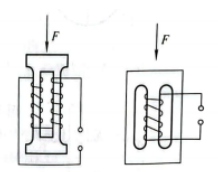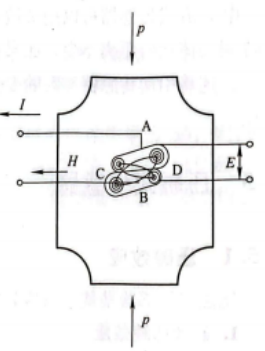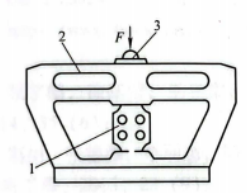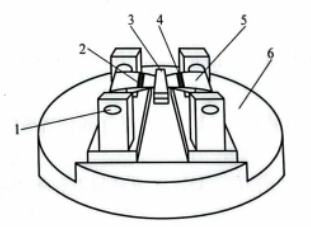Piezomagnetic sensor
1 Piezomagnetic effect
Piezomagnetic sensor is based on piezomagnetic effect, which is the inverse effect of magnetostriction.
1.1 Magnetostrictive effect
The phenomenon of mechanical deformation of some ferromagnets and their alloys, as well as some ferrites under the action of external magnetic fields is called magnetostriction effect or Joule effect. It is because the length of the magnetic domains inside these strong magnetic bodies in the direction of spontaneous magnetization is different from that of other directions, when there is no external magnetic field, the magnetic domains are disorderly, and the magnetization is balanced, when there is an external magnetic field, the equilibrium is destroyed, and the magnetic domains rotate, so that their magnetization direction is as far as possible to be consistent with the external magnetic field, so the length of the magnetic body along the direction of the external magnetic field changes. The amount of expansion is generally very small, and the scale of expansion is about 10-6 10-5mm. Magnetic materials with magnetostrictive effect include silicon steel sheet, permalloy and so on.
1.2 Piezomagnetic effect
Under the action of external force (or stress, strain), the magnetostrictive material causes internal deformation and produces stress, so that the boundary between the magnetic domains moves, and the magnetic domain magnetization vector rotates, so that the magnetization and permeability of the material change correspondingly. This phenomenon of changes in the magnetic properties of magnetic materials due to stress is called piezomagnetic effect, also known as inverse magnetostriction effect
When a piezomagnetic material is subjected to pressure, the permeability decreases in the direction of the applied force, but increases slightly in the direction perpendicular to the applied force: the applied force is the pull, and the result is reversed. After the force is cancelled, the permeability returns to its original value. The piezomagnetic effect is also related to the external magnetic field.
The piezomagnetic sensor is made of piezomagnetic effect, which can be used to measure physical quantities such as tension, pressure, weight, moment and bending moment.
2 Piezomagnetic sensor
Piezomagnetic force sensor is also known as magnetoelastic sensor, according to its working principle, can be divided into several structural forms such as choke coil, transformer, bridge, strain type, etc., of which choke coil, transformer and bridge are more used.
2.1 Piezomagnetic sensor
As shown in Figure 3-33, a piezomagnetic sensor with a choke coil has only one coil, which serves as both the excitation coil and the measurement coil. When alternating current is applied to the coil, the magnetic permeability of the core changes under the action of external force F, and the magnetic resistance and magnetic flux also change correspondingly, so that the impedance of the coil changes. Piezomagnetic transducers with choke coil can be used to measure pressure, which has the advantage of simple structure and reliable use.

2.2 Transformer piezomagnetic sensor
The transformer piezomagnetic sensor has two sets of coils, one is the excitation coil, the other is the measurement coil, and they are coupled by magnetism. Both the excitation coil and the measuring coil are wound around the piezomagnetic element. The piezomagnetic element is made of a ferromagnetic sheet bonded with an adhesive. Figure 3-34 shows the working principle of the transformer piezomagnetic sensor.
The silicon steel sheet is stamped into A certain shape, and there are four symmetrical punching holes A, B, C and D. In the four punching holes, there are two orthogonal coils A and B holes are the excitation coil, and C and D holes are the measurement coil, which is connected with the measurement circuit. When the piezomagnetic element is not subjected to external force, due to the isotropy of the core, the excitation coil produces concentric circular magnetic field, the magnetic field line is not intersected with the measuring coil, and the induced electromotive force output of the measuring coil is zero. When the piezomagnetic element is acted on by an external force, the permeability decreases along the direction of the external force, and the permeability increases perpendicular to the direction of the force, the magnetic field line becomes elliptical, and a part of the magnetic field line passes through the C and D coils, resulting in induced electromotive force. The greater the external force, the more magnetic flux with C and D, the greater the induced electromotive force.

Application of piezomagnetic sensor
Piezomagnetic sensor has the advantages of simple structure, good linearity, large output power, strong anti-interference ability, long life, easy maintenance, suitable for harsh working environment, etc., and is widely used in metallurgy, mining, printing, paper making, transportation and other industries.
1. Piezomagnetic force sensor
Figure 3-35 shows a typical piezomagnetic force sensor structure, which consists of a piezomagnetic element 1, an elastic beam 2, and a bearing steel ball 3. The function of the elastic beam is to apply pre-pressure to the piezomagnetic element and reduce the interference of the transverse force and bending moment, and the steel ball is used to ensure that the force F acts in the vertical direction. When a force is applied to a piezomagnetic element through a steel ball, an induced electromotive force proportional to the applied force is generated in the measuring coil on the piezomagnetic element.
2. Amorphous belt acceleration sensor
Figure 3-36 shows the structure diagram of the amorphous band acceleration sensor. The amorphous band is bonded to the support arm, and the vibrating block clamps the end of the amorphous band to form a closed loop. By adjusting the distance of the support arm, the amorphous has a suitable preload. The amorphous strip has an exciting coil and a measuring coil. The alternating current on the exciting coil generates a magnetic field that acts on the measuring coil to generate an induced electromotive force. When the amorphous strip is not stressed, the magnitude of the induced electromotive force generated by the measuring coil is only proportional to the rate of change of the magnetic induction intensity in the loop. When the amorphous belt is affected by a force, its permeability changes, and the induced electromotive force also changes. The force on the amorphous strip is proportional to the acceleration of the vibration block, so the amplitude of the induced electromotive force generated by the measuring coil is proportional to the acceleration of the vibration block.

Figure 3-35 Structure of the piezomagnetic force sensor

Figure 3-36 Structure diagram of the amorphous belt acceleration sensor



